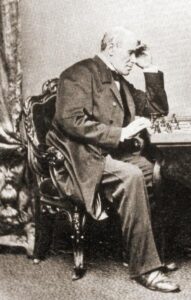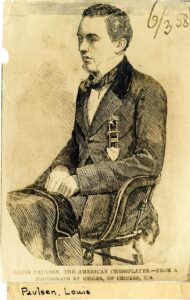1862 London Tournament
← Previous | Timeline | Next →
The 1862 London Tournament was the first international round-robin chess tournament, introducing both modern tournament structure and timed play through the use of sandglasses. Held during the second British International Exhibition, it attracted players from across Europe. Adolf Anderssen of Prussia won convincingly with a score of 12 out of 13 (losing only to Rev. John Owen), reasserting himself as the strongest player in the world during Paul Morphy’s retirement.

Winner: Adolf Anderssen
Born: July 6, 1818, Breslau, Prussia (now Wrocław, Poland)
Died: March 13, 1879, Breslau, Germany
Adolf Anderssen was the undisputed torchbearer of the Romantic chess era, revered for his dazzling attacks and fearless sacrifices. Immortalized by legendary masterpieces such as The Immortal Game and The Evergreen Game, he had already achieved global recognition by winning the inaugural London 1851 Tournament.
By 1862, with Paul Morphy retired from competition, Anderssen once again stood at the summit of European chess. His performance in London that year was a masterclass—12 wins from 13 games, conceding only a single loss. Combining bold creativity with razor-sharp calculation, Anderssen reaffirmed his dominance and left no doubt that he remained the world’s strongest active player.
«Contemporary press such as the Chess Player’s Chronicle (1862) praised Anderssen’s sacrificial style as artistic and visionary.»

Key Opponent: Louis Paulsen
Born: January 15, 1833, Blomberg, German Confederation
Died: August 18, 1891, Germany
Louis Paulsen was known for his remarkable defensive resilience and pioneering contributions to positional thinking at a time when most masters still favored bold attacks and sacrifices. His quiet, methodical approach stood in stark contrast to Anderssen’s flamboyant brilliance, emphasizing calculation, prophylaxis, and long-term planning. Paulsen’s second-place finish in London 1862 was not just a result of consistency—it was a statement of a new chess philosophy taking shape.
He preferred solid openings, restrained aggression, and deep endgame understanding, ideas that would later influence Wilhelm Steinitz and the foundations of modern positional play. Decades ahead of his time, Paulsen is now regarded as a precursor to the hypermodern movement, laying the strategic groundwork for thinkers like Aron Nimzowitsch and Richard Réti.
Tournament Overview
Dates: June–July 1862
Location: London, United Kingdom
Format: Round-robin, with 14 participants. All games played to a decisive result—draws were replayed.
Time Control: Sandglasses were used to limit move times, a precursor to modern chess clocks.
Prize Fund: Total £210 (approx. £26,000 in today’s money)
Prize Distribution:
1st: Adolf Anderssen — £100
2nd: Louis Paulsen — £50
3rd: John Owen — £30
4th: George A. MacDonnell — £15
5th: Serafino Dubois — £10
6th: Wilhelm Steinitz — £5 + Brilliancy Prize (vs. Mongredien)
Historical and Cultural Context
The tournament was held alongside the Second International Exhibition, underscoring chess’s cultural prestige in Victorian Britain. It marked a shift from informal gatherings to internationally organized events with rules, structure, and scheduling. The use of sandglasses reflected growing efforts to professionalize competition and ensure fairness.
Though Paul Morphy had retired, his legacy loomed. Anderssen’s triumph helped reaffirm Europe’s leadership in the chess world.
Final Standings
| Player | W | L | D | Total |
|---|---|---|---|---|
| Adolf Anderssen (Prussia) | 11 | 1 | 0 | 11 |
| Louis Paulsen (German Conf.) | 9 | 3 | 0 | 9 |
| John Owen (England) | 7 | 5 | 0 | 7 |
| George Alcock MacDonnell (Eng.) | 7 | 5 | 0 | 7 |
| Serafino Dubois (Italy) | 6 | 6 | 0 | 6 |
| Wilhelm Steinitz (Austria) | 6 | 6 | 0 | 6 |
| Thomas Wilson Barnes (England) | 6 | 6 | 0 | 6 |
| James Hannah (England) | 4 | 8 | 0 | 4 |
| Joseph Henry Blackburne (Eng.) | 3 | 9 | 0 | 3 |
| Johann Jacob Löwenthal (Hun.) | 3 | 9 | 0 | 3 |
📌 Draws were not recorded, as games were replayed until a decisive result was achieved. Players not shown in the table: Frederic Deacon, Augustus Mongredien, Valentine Green, James Robey.
1862 London Tournament Games
Game 1
Game 2
Game 3
Game 4
Game 5
Game 6
Game 7
Game 8
Game 9
Game 10
Game 11
Game 12
Game 13
1862 London Tournament
Adolf Anderssen, Prussia
← Previous | Timeline | Next →
1862 London Tournament Sources
Quote Sources
- Chess Player’s Chronicle, 1862: Commentary and coverage of Anderssen’s games. (British Library Archive)
General Sources
- Wikipedia:
- London 1862 Chess Tournament – Prize distribution and tournament details.
- Adolf Anderssen
- Louis Paulsen
- New in Chess Historical Edition: Insights into the significance of the 1862 tournament.
- 365Chess: 1862 London Tournament
- Edward Winter, Chess Notes: London 1862
- British Chess Magazine (1862): Archival issue – coverage and player profiles
- Deutsche Schachzeitung, 1862: Coverage in German via Google Books
- Olimpiu G. Urcan’s Historical Chess Blog: London 1862 retrospectives
- W. Steinitz: The Modern Chess Instructor (commentary on early career)
- Hooper & Whyld – Oxford Companion to Chess: Entry on 1862 tournament
- FIDE Archives: Early historical event references
Photo Credits
Adolf Anderssen Frans Peeters from Roosendaal The Netherlands CC BY SA 20 via Wikimedia Commons
Louis Paulsen, 1860s
Cleveland Public Library: Hesler (License: Public domain – United States) via Wikimedia Commons
Sources, image credits, and attributions for this championship are listed on this page. For general information about the World Chess Champions timeline, visit the main page.